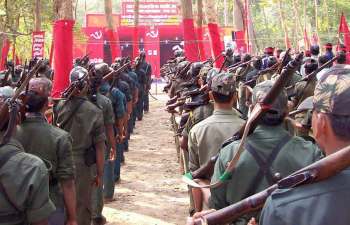 Many thanks to Ka Frank for sending this to us.
Many thanks to Ka Frank for sending this to us.
Present Political Situation – Our Tasks
CPI (Maoist) December 20, 2008
“Utilise the Excellent crisis situation!”
“Intervene and carry on each and every struggle of people!”
– A call by Indian Maoists
* * * * * * *
International Situation
During the past one year the crisis in the world capitalist-imperialist system has grown to levels unprecedented since the Great Depression of the 1930s. Manifested initially in the form of bursting of the sub-prime mortgage bubble in the US, it soon became the deepest financial crisis mainly in the US and then spread to EU, Japan and other parts of the world. By November 2008 it assumed the form of world recession after the US, 15-member Euro Zone and Japan officially declared their economies had entered a period of recession. Panic over the ever-deepening financial crisis soon gripped the real economy; exports fell and production had to be slowed down due to decrease in consumer spending in the US and Europe. The ongoing global crisis is not merely a financial crisis but a crisis encompassing all sectors of economy, social and political spheres in all countries.
The past year had seen many fluctuations in the prices of crude oil and commodities rising steeply in the first half and declining in the second half of the year. Reduction of area under food grains production led to acute shortages of food grains worldwide and high prices persisted for most part of the year. Food crisis has now become a worldwide phenomenon which will worsen further throwing a greater proportion of the world population into the clutches of poverty and hunger. In 2008 another 40 million people had joined the ranks of the hungry. Prices of oil ruled at record highs during the first eight months reaching a peak of $147 a barrel in August and then suddenly plummeting to more than half by September and reaching $40 a barrel by the third week of November due to drastic decline in automobile sales, lack of demand for land, air and sea transport. Not only oil prices but prices of many commodities like platinum, copper, steel and zinc have fallen by 35-40 % between July-September and agricultural commodities like soya and corn by over 50% due to the fall in demand resulting from steep declines in purchasing power of the people, industrial closures due to credit crunch and falling demand, and overall economic downturn. Widespread speculation in these commodities is also an important reason for the extreme fluctuation in their prices. Fall in prices of agricultural commodities has affected commodity-producing countries like Australia, Argentina, India and several countries of Asia, Africa and Latin America. Partial or complete closure of industrial giants and lay-offs of millions of workers has become a world-wide phenomenon in 2008. 17 out of 29 steel mill blast furnaces in the L S closed down due to lack of demand. Sales in automobiles, steel, software, electronics, retailing, transport had gone down steeply. Big Three in automobile Industry, which were the icons of American industrial supremacy until a few years ago, are now on the verge of collapse. House prices are the lowest since 1991. In Germany, G.M’s Opel plant was closed down. BMW and Diamler had ceased production for some months. Thus gloomy scenes of Depression are looming large on the scenario with continuing fall in demand for capital and consumer goods and even food grains. Agriculture too is badly affected due to non-availability of loans from banks.
Read the rest of this entry »



 Many thanks to Ka Frank for sending this to us.
Many thanks to Ka Frank for sending this to us. The following is a white paper from the
The following is a white paper from the